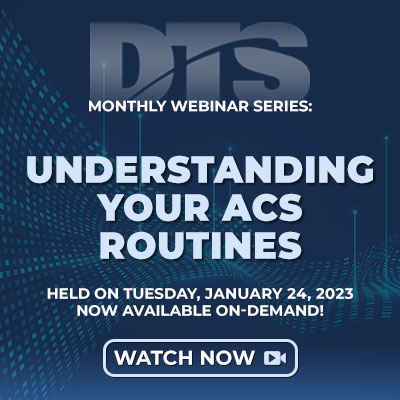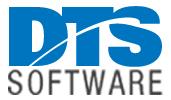DTS Webinar Recap: Understanding Your ACS Routines
2023 brought us back to the classroom in this installment of the DTS Complimentary Educational Webinar Series “Understanding Your ACS Routines.” While many of CTO Steve Pryor’s webinars take on a “teach by example” approach, this webinar, due to the very nature of the topic, took on a lecture style delivering a large amount of information in the allotted time, all of which is available to review on-demand. The slide deck, along with two help files (ACSINFO and ACSCOMP), which provide a REXX example of obtaining ACS routine change information from DCOLLECT, are available for download as well.
Understanding Your ACS Routines
In z/OS®, the Automatic Class Selection (ACS) routines lie at the heart of data set creation and use. Every data set, new or old, SMS managed or not, of whatever format, relies on the ACS routines to assign the proper SMS classes and control data set use. The ACS Routine language is simple, compact, and deliberately limited in scope, yet many installations suffer from large, unwieldy, confusing ACS routines containing ancient code which are updated only rarely and with trepidation.
In this webinar, we examine the ACS Routine language itself, the best practices and proper use of the language constructs, ACS testing, and provide some suggestions on how you can improve the ACS routines in your data center.
ACS Routines, an Early Form of Artificial Intelligence?
As z/OS grew (in form and popularity), the need for system-managed storage grew as well. The goal of ACS when released in 1989 was to relieve storage administrators of the many detailed, mundane tasks of adding and removing volumes and keeping track of where every data set was stored. In a word, automation.
ACS routines automate the task of determining the SMS classes and storage groups for data sets and objects in an SMS complex. For storage administrators, ACS routines automate and centralize the process of determining SMS classes and storage groups. ACS routines also help convert data sets to an SMS environment.1 But you can’t “set it and forget it.”
General Consensus: Most Every Installation’s ACS Routines are a Mess!
Fact is, most everyone’s ACS routines are a mess. Why? Because only the most experienced, knowledgeable storage administrators understand them in the first place. So as the years rock on, they are rarely updated, and changes are often poorly documented.
Numerous Problems Can Occur Due to Incorrect, Outdated, or Misunderstood ACS Routines
- Data sets can be allocated to incorrect locations (wrong storage group) leading to out-of-space conditions, performance issues, or access issues such as enqueue conflicts.
- Data sets not correctly backed up/archived/restored (wrong management class) lead to availability issues and possible restore failures.
- Data sets get incorrect space or other allocation characteristics (wrong data class) leading to out-of-space conditions such as X37 ABENDs or IEC070I VSAM errors.
- Data sets get wrong encryption key label, wrong VSAM RLS attributes, or other incorrect attributes.
You Set the Policies, ACS Routines Are the Enforcer
The ACS routines, along with the storage management policies, reside in a collection of data sets that IBM® refers to as the SMS Configuration. The Source Control Data Set (SCDS) is where ACS routines are defined and updated. But they are not active here. They become active when copied to another VSAM data set, the Active Control Data Set (ACDS).
The ACDS provides the active configuration – the storage management policies – that are being executed. Other elements of the configuration are the Communication Data Set, which contains space statistics and other real-time information about the SMS complex, and the SYS1.PARMLIB member (IGDSMS00), which contains a number of SMS parameters (40 to 50 or so) that influence what the ACS routines see, and the way data sets are allocated.
Examples and Additional Resources
As with every DTS webinar, the video, slide deck, and example files that accompany the webinar provide usable, helpful information in today’s z/OS shop. Pryor also includes information on key reference resources available for those who need it.
Steve makes himself available as an additional resource as well and can be reached at steve@dtssoftware.com.
Want a Free Analysis of Your ACS Routines?
Did you know DTS Software offers a free analysis of your ACS Routines? Let our team of coding experts provide recommendations on how to make the code more understandable, readable, and efficient. We’ll look for “dead code,” duplicate or confusing logic, and possible performance issues, and provide ease of understanding of the analysis. Learn more and sign up for your free analysis on our website.
Learn More in Our Webinar Available On-Demand Along with the library of past webinars, “Understanding Your ACS Routines” is a 60-minute informative and educational look at an important topic in the mainframe space. If you weren’t able to attend or would like to review the material presented, you can view it on-demand and download a copy of the slide deck to keep as reference material. Be sure to join us each month for our complimentary webinar series. Go to www.dtssoftware.com/webinars for more information.
Along with the library of past webinars, “Understanding Your ACS Routines” is a 60-minute informative and educational look at an important topic in the mainframe space. If you weren’t able to attend or would like to review the material presented, you can view it on-demand and download a copy of the slide deck to keep as reference material. Be sure to join us each month for our complimentary webinar series. Go to www.dtssoftware.com/webinars for more information.

